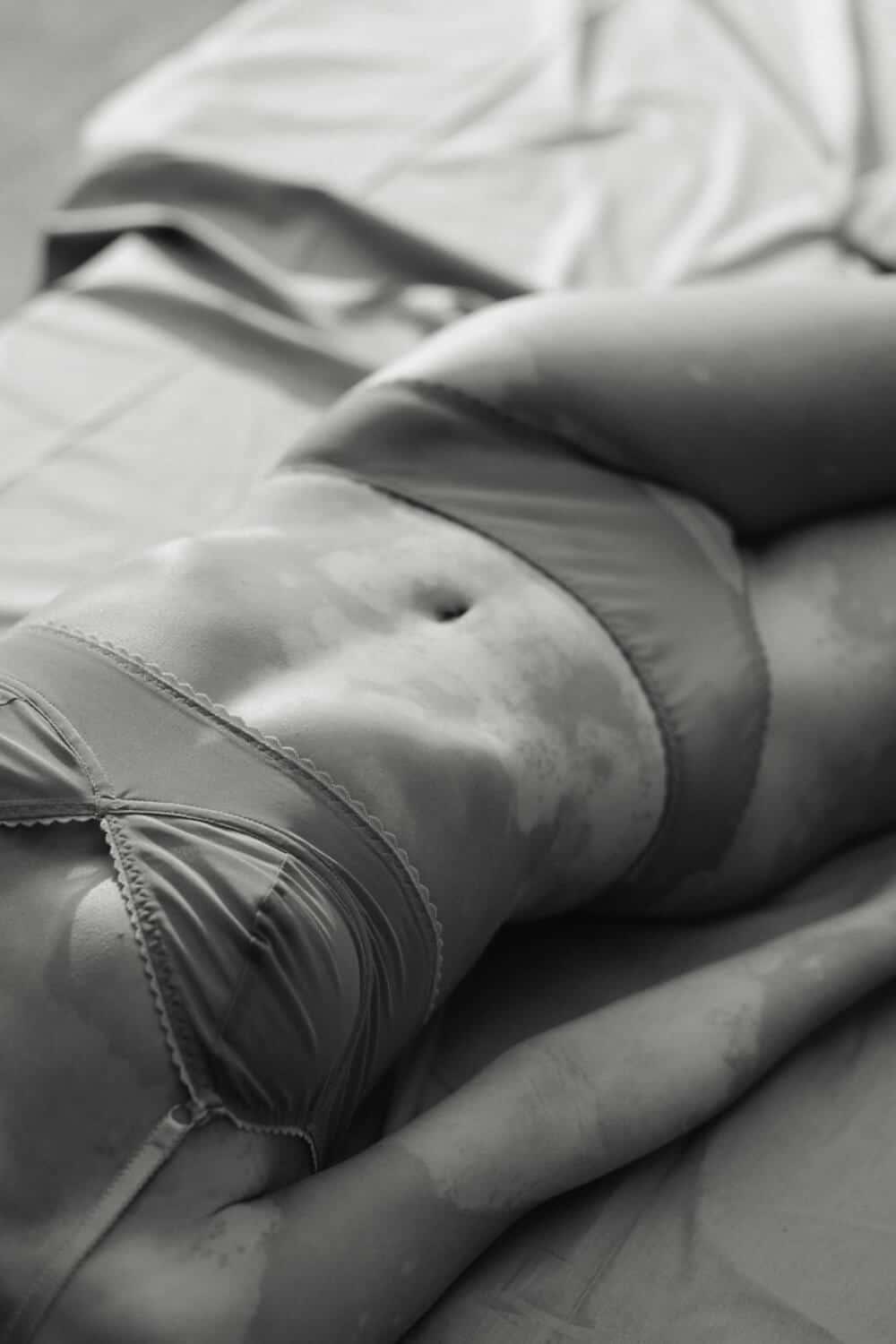A tummy tuck gives you back a harmonious figure

In brief
What motivates people to have a tummy tuck?
A constant struggle over the years between weight gain and weight loss is very likely to lead to a loss of elastic fibers in the subcutaneous fatty tissue. This is particularly noticeable on the abdomen. Patients often have a long history of suffering behind them. Exercise and a change in diet may lead to a reduction in volume, but the skin simply continues to “hang”.
Although this is completely natural, it is often perceived as a burden. At an advanced stage, skin irritation and inflammation often develop in the sagging skin folds. If the quality of life suffers as a result, patients often long for a permanent solution.
What is a tummy tuck?
Duration
from 120 min
Pain
low
Scars
in bikini area
Stay
one night
Bandage
4 weeks
Work
10 days
Sports
6 weeks
Costs
from € 5.500,-
What are the different methods?

Who is abdominoplasty suitable for?
When is the best time?
Who is it not suitable for?

What is the technical procedure for a tummy tuck?
All questions are clarified in advance in a detailed consultation and the incision is discussed. The operation begins with a final discussion and drawing of the incision lines.
After anesthesia, the excess skin and underlying fatty tissue are carefully and symmetrically removed. Smaller tummy tucks mainly affect the area below the belly button. Larger tummy tucks cover the entire abdominal wall area. Here, the belly button is freed from the surrounding skin during the operation and repositioned after the abdominal wall has been lowered. If a rectus diastasis is present, this is also exposed and sutured accordingly. Abdominoplasty mainly affects the front area of the abdominal wall. If there is also increased fatty tissue on the flanks, this is shaped during the operation by liposuction.
Once this has been completed and the new shape has been achieved, the multi-layered tissue is closed. Wafer-thin sutures running through the skin are used for the final skin closure. If necessary, Redon drainage tubes are inserted for 1-2 days to allow wound fluid to drain away.
Scars are unfortunately unavoidable and correspond to the incision. A distinction is made between the following:
The skin is then closed. Here the scar is placed as inconspicuously as possible in the lower part of the abdominal wall, concealed by your underwear.
Mini-abdominoplasty with a vertical, slightly curved incision for smaller excess tissue. The abdominal fat is localized more on the lower abdomen. The scar runs transversely between the hip bones, a few centimeters above the pubic mound. The scar can be easily covered with underwear.
Abdominoplasty with umbilical offset for medium to large excess tissue. The sagging abdominal fat extends from the costal arch to the lower abdomen. The scar around the lower area is similar to that of a mini-abdominoplasty, but can extend to the flank on both sides. There is also a circular scar around the navel.
Fluer de lis or “inverted” T-scar for large excess skin/soft tissue. The anchor incision enables tightening in the lower area and on both flanks. In this extreme form, the extended skin/soft tissue area is tightened on all sides. The resulting scar resembles an inverted “T”. It is a combination of a horizontal scar above the pubic bone and a vertical scar from the sternum to the pubic bone.
Surgical and conservative alternatives
There are various conservative and surgical alternatives for many operations. It is therefore necessary to consider these carefully before any surgical intervention. If the use of a scalpel can be dispensed with due to conservative alternatives, these are of course preferable.
Bodytite treatment, for example, is available as a minimally invasive alternative. This uses radiofrequency therapy to stimulate contraction of the connective tissue and tightening of the skin. However, this procedure is only useful for moderate soft tissue excess. Liposuction is also an alternative and saves a visible scar. Your body has a certain “retraction capacity”, an ability to tighten sagging tissue to a small degree. Whether this is possible should definitely be clarified during a physical examination.
Exercise, alternating showers and massages generally promote blood circulation and are ideal for preventive body care. However, despite various myths, none of these methods can regenerate sagging connective tissue. In this case, only surgery will bring effective change.
What type of anesthesia is necessary?
Can the procedure be combined with other procedures?

Photos


Is this operation performed on an outpatient or inpatient basis?
We usually perform minor tummy tucks on an outpatient basis in our practice. A total of 3-4 hours should be planned. Even if the actual operation time is 1.5-2 hours, the time for preparation and follow-up must be taken into account. For example, the sleeping pills need to be taken. You are welcome to stay in our surgery until you feel fit again. Immediately after waking up, you may experience slight circulatory weakness. Active participation in road traffic should be avoided at all costs for the first 12 hours. We recommend that you are accompanied for the first few hours after the operation and for the first night.
An inpatient stay is strongly recommended for larger tightening operations. As a rule, an overnight stay of 1-2 days in a private hospital is sufficient.
Risks and complications
Surgery is a wonderful routine for us. Nevertheless, we are aware that many of our patients may only have surgery once in their lives. It is therefore essential that you are informed about all the possible consequences of this procedure.
During surgical procedures, skin and tissue as well as underlying structures are treated with sharp instruments. Despite all caution, complications of varying severity can occur. During the initial consultation, we will go through a corresponding information sheet with you.
Minor complications
Abdominoplasty is a procedure with relatively few complications. If performed carefully, the risk of permanent consequences is very low. As with all surgical procedures, there may be minimal pain, comparable to moderate muscle soreness, as well as swelling and hematomas.
Slight asymmetries, scar widening, seromas, wound healing disorders and temporary loss of sensation are exceptions and usually disappear on their own. In our experience, swelling, restricted movement and the gentle posture caused by an abdominal bandage are well tolerated.

Rare major complications
What to do in the event of complications?
Healing and progression
How long does the recovery take?
You will certainly feel well again quickly and will only notice restrictions for a few days. Nevertheless, physical rest is crucial in the first 6 weeks after the operation in order to allow the deep tissue enough rest to regenerate. It takes 6-12 months until complete healing. During this time, the last swellings disappear and the abdomen takes on its final shape.
With the exception of competitive sports, sporting activities are possible after 6-8 weeks.
Of course, these time recommendations are guidelines based on our experience, which sometimes require individual adjustment.
Your body will take the time it needs.
Is the treatment painful?



“Wieder ein ausgezeichnetes Ergebnis der Botox-Behandlung! “
“I love Morpheus 8. My favorite!“
“Ich habe erheblich mehr Schmerzen nach dem Eingriff erwartet und war positiv überrascht wie gut es mir noch am selben Tag und jetzt an Tag 2 geht. Der Tag der...
“Ich war heute zum wiederholten Mal für eine Botox-Behandlung bei Dr.Lutfi und werde mich auch in Zukunft nur von ihm behandeln lassen. Sollte ich jemals andere...
“Kompetente und ausführliche Beratung und super Behandlung (Botox gegen Lachfalten). Bin mit dem Ergebnis sehr zufrieden und komme gerne wieder! “
When can the final result be expected?
The result of a tummy tuck is immediately visible. Important: The abdominal wall initially appears somewhat “over-tightened”. After about 3 months, the connective tissue structures will have settled and the abdomen and flanks will have reached their final shape.
The “durability” of a tummy tuck depends on your connective tissue and the quality of your skin. The more stressed these have been over the years, the more likely it is that there will be minimal sagging. However, this would be significantly less pronounced than the original sagging.
What should patients plan for?
A surgical procedure requires a certain amount of planning and organization not only for the surgical team, but also for the patient, both before and after the operation. It is important that you are well prepared and know what to expect. This allows you to concentrate fully on enjoying the results.
One of the most important questions before any surgical procedure is the “why”. You should be clear about why you want to have surgery at all. Once you have answered this question and made a decision, the following questions should definitely be clarified: How? By whom? When?
I will be delighted if you find your way to my surgery and would like to be operated on by me. However, I also recommend all my patients to get a second opinion. You should be absolutely sure about the date and surgeon.
Plan the time before your operation
Before any abdominal wall surgery, we recommend a general medical check-up to ensure that there are no underlying diseases or hernias in the abdominal wall.
As soon as you have decided to have the operation after a detailed consultation and medical history, you should plan the time after the operation with those around you accordingly. Although you should not expect to be out of action for any length of time, you may occasionally experience temporary movement restrictions.
Plan the time after your operation

What does the operation cost?

Financing, down payment, payment by installments
FAQ - Abdominoplasty
Plastic surgery
- Home
- About Me
- Aesthetic surgery
- Aesthetic treatments
- Before After Archive
- Ordination
- For doctors
- Contact
- Cost

